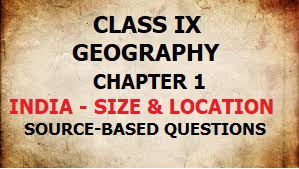Geography Source-Based Questions With Answers From Chapter 1
Geography Source-based questions (SBQ) in Social Science is a new introduction in the question paper by CBSE. What is unique about Geography source-based questions? While the topic is from the textbook, the questions may not be directly from the paragraph. How can a student perform well if the questions are from outside the textbook? Well, a student needs to apply the following three strategies to attempt Geography source-based questions (SBQ). They are:
Firstly, Read the chapter line by line.
Secondly, Develop an understanding of the topic.
Thirdly, Practice a lot to master source-based questions.
India-Size & Location – Chapter 1 For Practice

Geography source-based questions for class IX students
Q1. Geography Source-Based Questions From India – Size & Location
India is a vast country. Lying entirely in the Northern hemisphere. The mainland extends between latitudes 8°4’N and 37°6’N and longitudes 68°7’E and 97°25’E. The Tropic of Cancer (23° 30’N) divides the country into almost two equal parts. To the southeast and southwest of the mainland, lie the Andaman and Nicobar islands and the Lakshadweep islands in the Bay of Bengal and the Arabian Sea respectively. Find out the extent of these groups of islands from your atlas. The land mass of India has an area of 3.28 million square km. India’s total area accounts for about 2.4 percent of the total geographical area of the world. India is the seventh largest country in the world note that the latitudinal and longitudinal extent of the mainland is about 30°. Despite this fact, the east-west extent appears to be smaller than the north-south extent.
Read the paragraph carefully and answer the following questions:
i) What is the Latitudinal extent of India? 1.
a) 8°4’E and 37°6’W
b) 8°4’N and 37°6’S
c) 8°4’N and 37°6’N
d) 8°4’S and 37°6’S
Ans. c) 8°4’N and 37°6’N
ii) What is the Longitudinal extent of India? 1.
a) 68°7’E and 97°25’E
b) 68°7’W and 97°25’E
c) 68°7’E and 97°25’W
d) 68°7’N and 97°25’S
Ans. a) 68°7’E and 97°25’E
iii) Why the east-west extent of India appears to be smaller than the north-south extent? 2.
Ans. The distance between lines of latitude remains the same from the equator to the poles.
But, the distance between the lines of longitudes decreases as we move towards the poles.
India is slightly above the equator.
So, the lines of longitude come nearer and the East-West distance becomes less than the North-South distance.
8 Facts About Latitudes and Longitudes Which Is Not Explained In Schools
Q2. Topic: India’sLocation and Standard Time Meridian
India is bounded by the young fold mountains in the northwest, north, and northeast. South of about 22° north latitude, it begins to taper and extends towards the Indian Ocean, dividing it into two seas, the Arabian Sea on the west and the Bay of Bengal on its east. Note that the latitudinal and longitudinal extent of the mainland is about 30°. From Gujarat to Arunachal Pradesh, there is a time lag of two hours. Hence, time along the Standard Meridian of India passing through Mirzapur (in Uttar Pradesh) is taken as the Indian standard time for the whole country. The latitudinal extent influences the duration of day and night, as one moves from south to north.
Read the paragraph carefully and answer the following questions:
i) Name the young fold mountains that bound India from the northwest, north, and northeast. 1.
a) Aravalis
b) Himalayas
c) Karakoram
d) Purvanchal hills.
Ans. b) Himalayas
ii) If the time at the easternmost longitude of India is 11:30 P.M. What will be the time at the westernmost longitude of India? 1.
a) 1:30 A.M.
b) 1: 30 P.M.
c) 9:30 A.M.
d) 9:30 P.M.
Ans) d) 9:30 P.M.
How to calculate time using longitudes explained Step by step
iii) Which Longitude is considered the Indian Standard Time meridian for India and why? 2.
Ans) 82°30’E Longitude is considered the Indian Standard Time meridian for India.
This is because India’s Longitudinal extent is 68°7’E and 97°25’E.
It means almost 30 longitudes pass through India.
We know that there is a time difference of 4 minutes between two longitudes.
In such a case time at every place in India will be different and will create a lot of confusion.
Therefore, 82°30’E Longitude which passes through the center of India has been considered the Indian Standard Time meridian for India to avoid such confusion.
Q3. Topic: Source-Based Questions From India and The World
The Indian landmass has a central location between East and West Asia. India is a southward extension of the Asian continent. The
trans-Indian Ocean routes, which connect the countries of Europe in the West and the countries of East Asia, provide a strategic central
location for India. Note that the Deccan Peninsula protrudes into the Indian Ocean, thus helping India to establish close contact with West Asia, Africa, and Europe from the western coast and with Southeast and East Asia from the eastern coast. No other country has a long coastline on the Indian Ocean as India has and indeed, it is India’s eminent position in the Indian Ocean, which justifies the naming of an Ocean after it.
Read the paragraph carefully and answer the following questions:
i) What provides a strategic central location for India? 1.
Ans. The trans-Indian Ocean routes, which connect the countries of Europe in the West and the countries of East Asia, provide a strategic central location for India.
ii) How did India get benefit from its long coastline? 1.
Ans. The Deccan Peninsula protrudes into the Indian Ocean, thus helping India to establish close contact with West Asia, Africa, and Europe from the western coast and with Southeast and East Asia from the eastern coast. No other country has a long coastline on the Indian Ocean.
III) Give two reasons which justify the naming of an Ocean after India. 2.
Ans. Two reasons which justify the naming of an Ocean after India are:
a) India’s eminent position in the Indian Ocean
b) No other country has a long coastline on the Indian Ocean as India has.
PHYSICAL FEATURES OF INDIA – CLASS IX
4. Topic: India and the World
India’s contacts with the World have continued through ages but her relationships through the land routes are much older than her maritime contacts. The various passes across the mountains in the north have provided passages to the ancient travelers, while the oceans restricted such interaction for a long time. These routes have contributed to the exchange of ideas and commodities since ancient times. The ideas of the Upanishads and the Ramayana, the stories of Panchtantra, the Indian numerals, and the decimal system thus could reach many parts of the world. The spices, muslin, and other merchandise were taken from India to different countries. On the other hand, the influence of Greek sculpture, and the architectural styles of domes and minarets from West Asia can be seen in different parts of our country.
Read the paragraph carefully and answer the following questions:
i) Do you think the ocean routes helped India to establish close contact with the world during ancient times? 1.
Ans. No, it is the land routes and the passes across the mountains that helped India to establish close contact with the world during ancient times.
ii) What is India’s contribution to the world? 1.
Ans. India has contributed the ideas of the Upanishads and the Ramayana, the stories of Panchtantra, the Indian numerals, and the decimal system along with spices and muslin to the world.
iii) What India has learned from other countries of the world? 2.
Ans. a) Greek sculpture, and
b) the architectural styles of domes and minarets.
5. Topic: Source-Based Questions From India’s Neighbours
India occupies an important strategic position in South Asia. India has 28 states and Eight Union Territories India shares its land boundaries with Pakistan and Afghanistan in the northwest, China (Tibet), Nepal and Bhutan in the north, and Myanmar and Bangladesh in the east. Our southern neighbors across the sea consist of the two island countries, namely Sri Lanka and the Maldives. Sri Lanka is separated from India by a narrow channel of sea formed by the Palk Strait and the Gulf of Mannar, while the Maldives Islands are situated to the south of the Lakshadweep Islands.
i) Name a newly formed state and union territory of India? 1.
Ans. State – Telangana
Union Territory – Ladakh
ii) Sri Lanka and the Maldives lie in which sea/oceans? 1.
Ans. Both lie in the Indian Ocean.
iii) What is the old name of Myanmar? Which Indian states share borders with Myanmar? 2.
Ans. Burma is the old name of Myanmar.
Arunachal Pradesh, Nagaland, Manipur, and Mizoram are the Indian states that share borders with Myanmar.
Conclusion: Source-Based Questions From India – Size & Location
Geography source-based questions are not very easy to answer. You need to practice a lot to answer Geography source-based questions. India – size & location is a small chapter but it has many concepts of Geography. Therefore, many types of source-based questions can be asked in this chapter. Solve all the above Geography source-based questions before going to the examination hall. I Hope, these Geography source-based questions will increase your understanding. Finally, It will also help you to easily attempt Geography source-based questions.
Now, would you like to attempt a challenging question?
What is the capital of Myanmar? Do write to me as soon as possible.
All the best.
You may like to read
Class IX Geography NTSE- Most expected questions
Project On Tsunami: 13 Pages You Must Include In Your Disaster Management Project




Great Article Nice Information Enjoyed Reading It Thankyou for Sharing it
Thank you Kamaljeet. Keep visiting. Very soon we are going to upload more questions.